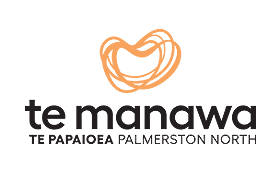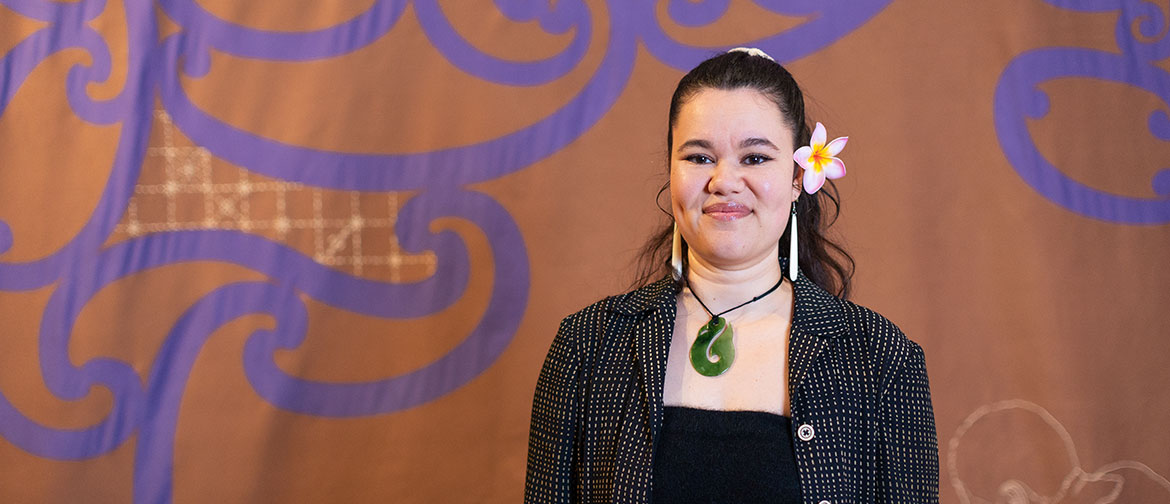A tivaevae blended with Māori motifs: how did you decide on that as your big project?
I’ve always been drawn to kōwhaiwhai, even before I started studying at Massey, which is where I really learned about it, in my first year at Toioho ki Āpiti. From there I’ve seen these Samoan-type patterns on the bodies of my whānau in Samoa. I had artist models that I was inspired by like Cora-Allan Wickliffe – she takes her nation’s version of siapo, called hiapo, and she makes space within them for different figures. That’s what I decided to do as well, make space within the kōwhaiwhai, like a portal into other parts of my whakapapa.
What was the biggest challenge with creating the kōwhaiwhai, in practical terms?
The scale of it was really difficult for me to manage, because I’d never done anything this big before. Because it’s all hand stitched I needed a lot of help. Luckily I have amazing friends and whānau who were able to help with the stitching along the edges – the whip stitch so that it doesn’t fray. And then my beautiful kaiako at Massey helped me with the embroidery parts, and the stitching as well.
And that’s part of the philosophy of making a tivaevae, right?
Yeah. That’s how I imagine they did it – and still do it, you just have a community with wahine all together telling jokes and having yarns and bringing art pieces like this into life.
Is the pattern of the kōwhaiwhai representative of anything in particular?
The specific pattern that I’m using a lot of is called kōwhai ngutukākā, because it’s recursive, and for me it represents the journey my whānau has taken from Samoa to Aotearoa, back to Samoa – going back and forth. Also that’s one of the patterns that the master of kōwhaiwhai, Sandy Adsett, loves to use, so it’s a bit of a tribute to him as well.
Was it difficult to transition between the alternating colours on front and back?
Kind of. With kōwhaiwhai you have to work with positive and negative space; that’s an integral part of it, one can’t exist without the other. What’s on the other side is the negative space here, and it’s all one piece. So everything that’s blue here is brown on the other side, and I could just take it, put it down, iron it on and then sew it. In that sense the other side was probably easier.
So you weren’t having to deal with large amounts of fabric going in all directions.
Oh, I was! But at least it was one piece, so it was a bit better.
The white stitching in the middle of the large field, what does that represent?
These are stars. All the white stitching is made of muka. Over the year I learned how to extract muka from the harakeke. Me and one of the other fourth-years, Aroha [Millar], we went through her garden and harvested the harakeke and extracted the muka. Funnily enough I was on a noho marae earlier this week in the Wairarapa, and I was able to share some of that knowledge with the other women there who hadn’t done it before. That was cool to be able to do.
Were there any other parts of making the tivaevae that you were learning or doing for the first time?
Yes, all of it. Tivaevae’s not really a Samoan thing, it’s a Cook Islands thing, and Hawai’i and Tahiti. The reason I was inspired by tivaevae is because I don’t have the knowledge or materials here to make a real siapo – or even a whāriki, because I’m not a weaver. I admired how they could take these materials that were brought to them and make a new art form out of it, so it’s a tribute to that as well. The blue is hand dyed – I dyed it myself, so that was a new thing for me to learn how to do. And in big quantities of fabric as well! I went through two or three dye batches before the colour came out how I wanted it.
A tivaevae can have a practical use too, as well as being an artwork, is that right?
Yeah. In the Cook Islands they use it for weddings and graduations. And it’s a quilt too, so it can go on a bed. In Samoa we use siapo for lots of things, like as a present, or when you’re doing the fa’a Samoa, the traditional ceremonies. In Māoridom, you can use the whāriki, the fine mats, for tūpāpaku as well. My Samoan whanau in Aotearoa use the fine mats and the king mats at funerals or celebration, hanging them on the walls, and on the floor. It can be used practically that way, and I hope it will be a taonga for my whānau.
What was the most number of people who were working on it at one time?
Maybe five or six, but altogether more than twenty people contributed. I’m very grateful.
Will you continue to work with textiles in the future?
I hope so. It’s been really rewarding, learning how to use muka, embroidery and hand stitching. At times it was stressful, because I had a time limit, but it was a beautiful process as well, so I hope going forward I will continue with the muka for a bit longer.




